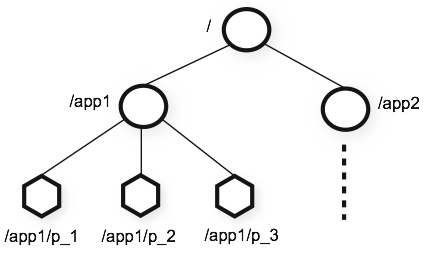One of my interests is distribute computing for data research, so it made me looking on open source projects for this feature. One of important point in distribution is managing status of each server, and communicating between them. I found out lots of them(such as storm, kafka, and much more) are using zookeeper for this feature, and this is why I started to looking on it.
What is zookeeper
Zookeeper is a service for coordinating distributed system. It includes feature for configuration management, synchronization, group services, etc. and these are offered with simple interface to make easy usage for developers.

This is simple sketch of Zookeeper managed system. In this diagram, server means the machine which zookeeper actually runs, and client is the target which are being managed.
Zookeeper service is made up with multiple server for managing each componenets in distribution system. One of them becomes a leader, and others are called follower. As you see in image, followers service clients and all updates go through order of follower -> leader -> other followers.
Zookeeper data model
Data in zookeeper is for store coordination data of service, like status information, configuration, location information, and more. It uses a data model styled after the familiar directory tree structure of file systems.

These data nodes are being called znode. Each of them are identified with name and seperated by sequence of path. Every znode maintains a stat structure. A stat simply provides the metadata, which has version number, action control list (ACL), timestamp, and data length information.
There are 2 types of node, Persistence znode and Ephemeral znode. Ephemeral znode are kept alive only while client session is connected, and deleted automatically when connection is lost. On the contrary, persistence znode are persistent regardless of client state unless it has been specified changing state.
Start zookeeper
Start with install zookeeper. You can download from release page or use brew if using Mac. Use zkServer command for zookeeper.
{% highlight shell %} {% raw %} $ brew install zookeeper … // after install $ zkServer ZooKeeper JMX enabled by default Using config: /usr/local/etc/zookeeper/zoo.cfg Usage: ./zkServer.sh {start|start-foreground|stop|restart|status|upgrade|print-cmd} {% endraw %} {% endhighlight %}
Configuration for zookeeper service are being set in zoo.cfg. If you want to connect multiple server, add server list here as server.[seq number]=address. Instead just for test with single laptop, you don’t need to add this.
{% highlight shell %} {% raw %}
The number of milliseconds of each tick
tickTime=2000
The number of ticks that the initial
synchronization phase can take
initLimit=10
The number of ticks that can pass between
sending a request and getting an acknowledgement
syncLimit=5
the directory where the snapshot is stored.
do not use /tmp for storage, /tmp here is just
example sakes.
dataDir=/usr/local/var/run/zookeeper/data
the port at which the clients will connect
clientPort=2181
the maximum number of client connections.
increase this if you need to handle more clients
#maxClientCnxns=60 …
add server list for connection
server.1=192.168.0.1:2888:3888 server.2=192.168.0.2:2888:3888 server.3=192.168.0.3:2888:3888 {% endraw %} {% endhighlight %}
Now open 2 terminal window and start service.
[1] {% highlight shell %} {% raw %} $ zkServer start-foreground ZooKeeper JMX enabled by default Using config: /usr/local/etc/zookeeper/zoo.cfg {% endraw %} {% endhighlight %}
[2] {% highlight shell %} {% raw %} $ zkCli -server 127.0.0.1:2181 Connecting to 127.0.0.1:2181 Welcome to ZooKeeper! JLine support is enabled [zk: 127.0.0.1:2181(CONNECTING) 0] WATCHER:: {% endraw %} {% endhighlight %}
This is totally simple!. It tells that it has been connected to zkServer. Now let’s see the data model.
{% highlight shell %} {% raw %} [zk: 127.0.0.1:2181(CONNECTED) 1] ls / [zookeeper] [zk: 127.0.0.1:2181(CONNECTED) 2] ls /zookeeper [quota] [zk: 127.0.0.1:2181(CONNECTED) 3] ls /zookeeper/quota [] {% endraw %} {% endhighlight %}
There are only one root directory ‘zookeeper’ and there are one child ‘quota’. You can make new ones with create <path> <data> command. With -s flag, it creates sequential node. To see information of node, use get <path>.
{% highlight shell %}
{% raw %}
[zk: 127.0.0.1:2181(CONNECTED) 2] create /new-node node1
Created /new-node
[zk: 127.0.0.1:2181(CONNECTED) 3] get /new-node
node1
cZxid = 0x1de
ctime = Tue Oct 17 00:40:36 JST 2017
mZxid = 0x1de
mtime = Tue Oct 17 00:40:36 JST 2017
pZxid = 0x1de
cversion = 0
dataVersion = 0
aclVersion = 0
ephemeralOwner = 0x0
dataLength = 5
numChildren = 0
[zk: 127.0.0.1:2181(CONNECTED) 4] create -s /second-node node2
Created /second-node0000000003
[zk: 127.0.0.1:2181(CONNECTED) 5] get /second-node0000000003
node2
cZxid = 0x1df
ctime = Tue Oct 17 00:43:00 JST 2017
mZxid = 0x1df
mtime = Tue Oct 17 00:43:00 JST 2017
pZxid = 0x1df
cversion = 0
dataVersion = 0
aclVersion = 0
ephemeralOwner = 0x0
dataLength = 5
numChildren = 0
{% endraw %}
{% endhighlight %}
Next goal
This is just a starting point of going on zookeeper. As I mentioned, the reason I started to looking on it is to see how this coordination system are being used in lots of distribution systems.